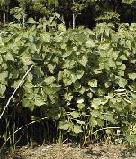Industrial hemp of Hokkaido -the challenge towards a future-
What is Hemp?
Hemp is thought to originate from Central Asia and is currently distributed throughout all areas of the globe. It was previously classified as a member of the mulberry family but following the establishment of the Cannabaceae family, hemp is now classified as the Cannabis genus of the Cannabaceae family. Cannabaceae Cannabis L. contains only this plant. It is a dioecious annual plant with a quick growth period of 2 to 4 meters in approximately 110 days.
One of its main features is the presence of the component THC (tetrahydrocannabinol) in its flower buds and leaves. As THC has psychoactive effects, it has garnered cannabis the image of being an “illegal substance.”
Moreover, cannabis is scientifically divided into “medicinal,” “intermediate,”
and “fiber” types. The large THC content in the medicinal form gives it
psychoactive effects but the fiber form has little THC content and barely
any psychoactive effects. The hemp that historically grew in Japan was
the fiber form and so the custom to use it as an “illegal substance” did
not exist in Japan.
Chemotypes of Cannabis sativa
| Chemotype | Predominant Cannabinoids |
THC content | Designation/ Products |
| Drug type | THC>CBD | > 2~25% | Marijuana, Hashish/ Medical and recreational use |
| Intermediate type |
THC=CBD | 0.3-1.0% | |
| Fiber type | THC<CBD | < 0.3% (EU < 0.2%) |
Industrial hemp/ fiber, oil |
Defining Cannabis and hemp
According to the Kojien Japanese Dictionary (5th Edition), “cannabis” is defined as “another name for hemp.” Historically in Japan the word “hemp” was directly related “cannabis,” and both pointed to a “crop that supported the work of the Japanese people.” Any mention of “hemp” in old documents of course referred to “cannabis” and usually throughout the documents “hemp” and was used with the exact same meaning “cannabis.” In daily use it was called “asa” (hemp) but when speaking of the plant with particular respect it was called “taima” in Chinese-style reading or “ohnusa” in native Japanese reading (cannabis). This relates to the important role the plant played in Shintoism.
On the other hand, there is a law established in 1962 called the Household Goods Labeling Law. In this law, “hemp” was designated to refer solely to the foreign products such as “flax” (Linaceae family) and “ramie” (Urticaceae family). Products of the “crop that supported the work of the Japanese people” were referred to as “undesignated fibers (cannabis).” With this law, after the Meiji period all flax(linen), ramie, and similar fibers brought into Japan from abroad were unfortunately lumped together under the single term “hemp.” As a result, the hemp product one imagines for the typical summer suit is something made from flax or ramie, and the same goes for items labeled as “actual hemp” or “true hemp.” It became illegal to label “cannabis” products as “hemp,” even though hemp and cannabis had historically been one and the same.
 |
 |
|
| Hemp | Ramie | Flax |
| Household Goods Quality Labeling Act (Act No. 104 of 1962) Order for Enforcement of the Household Goods Quality Labeling Act Cabinet Order No. 390 of September 29, 1962 Article 1 Household goods referred to in Article 2, paragraph (1) of the Household Goods Quality Labeling Act (hereinafter referred to as the "Act") are as per the appended table. (i) Textile goods 1. Yarn , hemp (limited to flax and ramie) |
Cannabis Control Act ; Act No.124 of July 10, 1948
Cannabis Control Act give special designation to the leaves and flower
buds of the cannabis plant, and forbid possession of those parts. There
are still no restrictions on the stem and seeds that had been used agriculturally.
However, attention has focused solely on the leaves and flower buds leaving
the stems and seeds’ existence to be forgotten. These matters have greatly
injured the understanding of “cannabis as an agricultural crop.”
Furthermore, the “hemp” receiving attention in the West as a new resource is a crop that has been bred to contain little to no THC and has no psychoactive effects, and “marijuana” is not another name for the same plant but rather a term referring to the dried flower buds of a female plant.
| Cannabis Control Act ; Act No.124 of July 10, 1948 Article 1 The term "Cannabis" as used in this Act means the cannabis plant (Cannabis Sativa L.) and its products; provided, however, that the grown stalk of the cannabis plant and its products (excluding resin.) and the seed of cannabis plant and its products are excluded. |